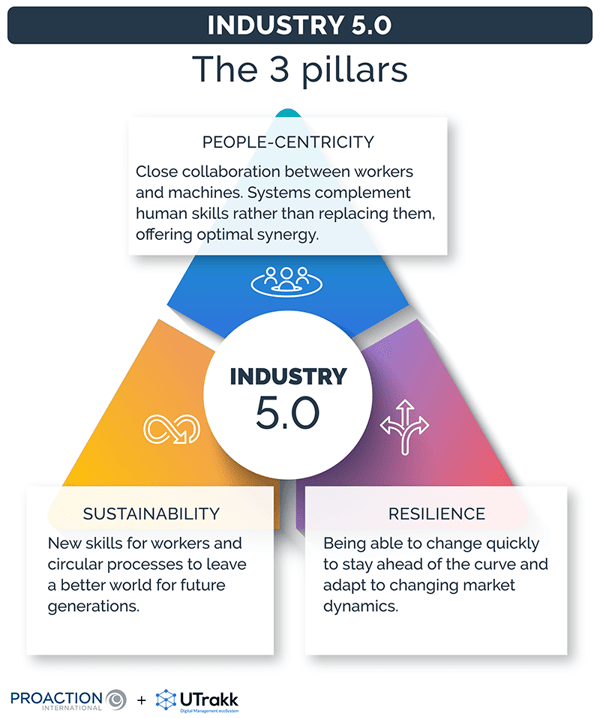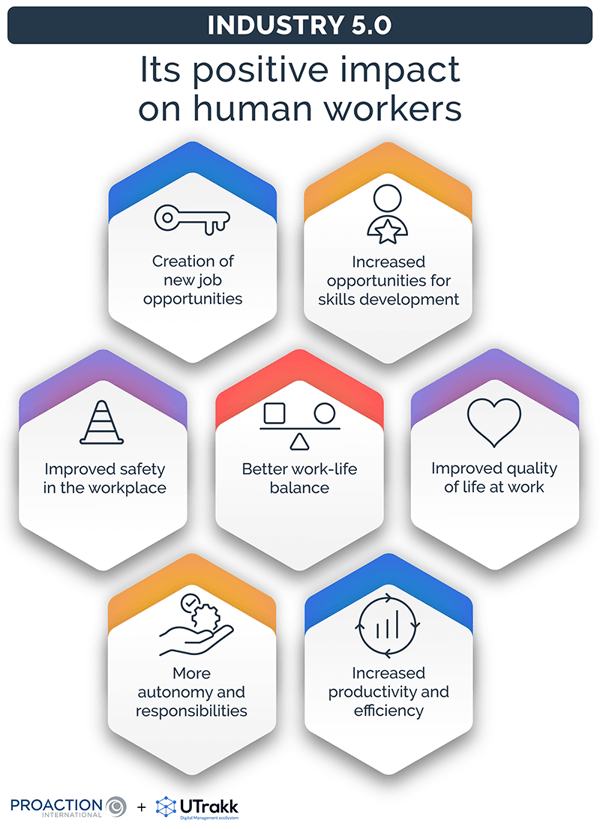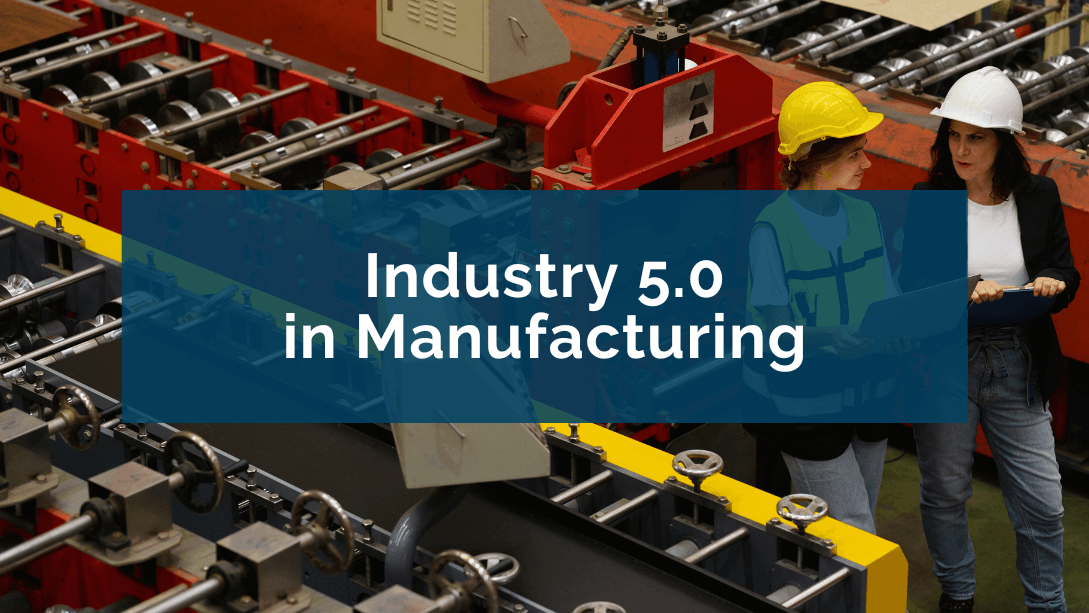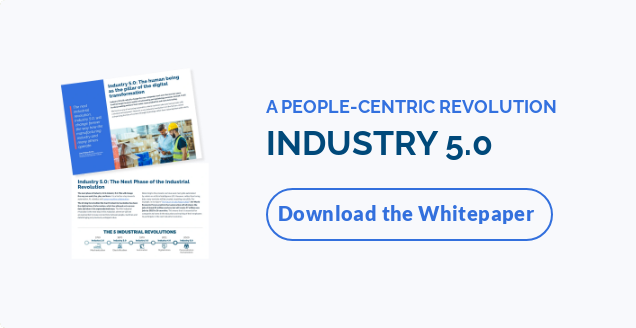What does the fifth industrial revolution mean for this sector?
Industry 5.0, the natural evolution of Industry 4.0, represents a fundamental change in how manufacturing processes are viewed.
Whereas the fourth industrial revolution was concerned with laying the foundations for digital transformation (automation, connectivity, the Internet of Things, Big Data analytics), version 5.0 goes far beyond, recognizing the limits of total industrial automation and seeking to maximize the added value of human labor: a human centric industry.
So, instead of relegating workers to the background, it puts them back at the heart of industrial production, creating a genuine symbiosis with cutting-edge technologies for a more balanced approach centered on the human factor.
Another critical point is that Industry 5.0 promotes sustainable development, the use of renewable energies, the preservation of natural resources, and recycling to minimize waste.
The concept of Industry 5.0 is not based on technologies but is centered around values, such as human-centricity, ecological or social benefits. This paradigm shift is based on the idea that technologies can be shaped towards supporting values, while the technological transformation can be designed according to the societal needs, not vice versa.

Integration of cutting-edge technologies and a human-centered approach
Industry 5.0 recognizes the complementarity between men and smart devices. It aims for the perfect balance between technological efficiency and the richness of human intelligence. Rather than simply automating tasks, it frees workers from repetitive actions and directs them towards more strategic roles.
The aim is to achieve environments where individuals interact closely with state-of-the-art equipment, making the most of each party's specific skills. Industry 5.0 thus fosters creativity, problem-solving, and innovation, essential for remaining competitive in the global marketplace.
From the European Commission's point of view, "the main assets of SMEs are often the experience and expertise of its employees and workers; a human-centered approach, including empowerment through supporting technologies, can safeguard these assets."
Key Industry 5.0 technologies and their use on the factory floor
Artificial intelligence (AI)
In the context of the manufacturing industry, AI makes automated processes more intelligent, adaptive, and efficient. It optimizes production planning, anticipates equipment failures, and improves operational efficiency and product quality.
Machine learning algorithms enable predictive maintenance, reducing unplanned downtime. In assembly, AI facilitates defect detection and optimizes supply chains.
However, artificial intelligence does not replace human workers. It is designed to collaborate with them, offering support in decision-making and solving complex problems.
Collaborative robotics
Collaborative robots, or cobots, are designed to work harmoniously alongside human operators. They must share the workspace without compromising safety.
These industrial robots assist employees in repetitive and physically demanding tasks, freeing time for more complex responsibilities.
Implementing this collaboration increases production efficiency and improves product quality while creating a more flexible, adaptive, and safe working environment.
Augmented reality (AR)
AR is revolutionizing industrial sectors by integrating virtual information into the working environment.
Used for training, it guides workers through assembly and maintenance procedures, improving efficiency and reducing errors.
During production, augmented reality presents real-time data on machines and inventory, optimizing productivity and quality.
Finally, AR enhances workplace safety by displaying instructions and warnings directly in the workers' field of vision.
Digital twins
Digital twins are virtual replicas of physical objects, manufacturing processes, or systems. They are used to model and simulate production operations and analyze them in real-time.
Thanks to them, workers can detect possible faults, optimize processes, and test scenarios without disrupting actual production lines. They can visualize and interact with this advanced technology to gain an in-depth understanding of current operations.
Additive manufacturing
Additive manufacturing, often called 3D printing, is emerging as an essential component of Industry 5.0. This revolutionary technology enables the creation of three-dimensional objects layer by layer, offering unrivaled flexibility and customization in the production process.
It makes manufacturing complex, customized parts possible, eliminating surplus inventory. Workers can design and print prototypes quickly, accelerating the product development process.
The technology also enhances human-machine interaction, as workers can integrate their creative skills and expertise into product design, while additive manufacturing turns these ideas into reality.
The positive impact of Industry 5.0 on human workers
The adoption of Industry 5.0 in the manufacturing sector has a significant and positive impact on the workforce, improving several critical aspects of the working environment.

Increased productivity and efficiency
Implementing advanced Industry 5.0 technologies significantly increases productivity and efficiency in operations. Repetitive and complex tasks are automated, enabling workers to concentrate on higher value-added activities, thereby increasing overall production.
Increased opportunities for skills development
Industry 5.0 means a highly skilled workforce. To meet these needs, companies are investing in training and skills development for their employees. It allows workers to acquire new technological knowledge and know-how, fostering long-term employability.
Interacting with advanced technologies also fosters the development of cross-disciplinary skills such as problem-solving, critical thinking and collaboration. Those skills are highly valued in today's professional world.
Improved safety in the workplace
Industry 5.0 intelligent machines help to enhance workplace safety and reduce the risk of accidents as robots take over dangerous tasks.
What's more, augmented reality provides real-time information on safety procedures, helping workers to make sound decisions to avoid potential hazards.
Better work-life balance
The adoption of Industry 5.0 significantly improves the work-life balance for workers. Advanced technologies such as constant connectivity, real-time monitoring and automation of repetitive tasks enable greater flexibility in working hours and the ability to work remotely.
It reduces the need for constant physical presence in the workplace, allowing workers to manage their professional tasks while meeting their personal commitments.
Improved quality of life at work
Man-machine symbiosis, combined with safer working conditions and more stimulating tasks, improves the quality of life at work and employee well-being. Workers feel valued by actively contributing to the production process and using their skills for more complex and rewarding tasks.
Industry 5.0 recognizes the power of industry to achieve societal goals beyond jobs and growth to become a resilient provider of prosperity by making production respect the boundaries of our planet and placing the wellbeing of the industry worker at the center of the production process.
European Commission
More autonomy and responsibilities
Industry 5.0 systems often give workers greater autonomy in managing their work. It fosters a sense of responsibility and individual accomplishment.
Creation of new job opportunities
Although some tasks are automated, Industry 5.0 also creates new job opportunities. The management, maintenance, and supervision of automated systems require human expertise.
Moreover, the ongoing development of new technologies opens the door to specialized and innovative jobs.
The future of manufacturing is driven by humans
It is about mobilizing collective intelligence, not least by considering workers’ experience as an asset and a source of innovation.
European Commission
Although the emergence of advanced technologies is transforming industrial processes, it is increasingly clear that the real driver of innovation and economic growth lies in human expertise, creativity, and adaptability.
In manufacturing in particular, workers are indispensable for anticipating market needs, continually innovating, coordinating complex operations and making decisions. As machines evolve to increase efficiency, they should be seen as a complement amplifying human skills, rather than as a replacement.
The future of the industrial sector therefore lies in a synergistic collaboration between man and technology, where the potential, the unique assets of each party are harnessed to create a dynamic, efficient and resilient working environment.
Industry 5.0 doesn't replace people; it magnifies them. It's not just a technological progression but a new human-centric approach that reaffirms the role of workers in manufacturing plants. By embracing this vision, manufacturers position themselves not only to meet challenges, but also to define a more humane, prosperous and sustainable future.









